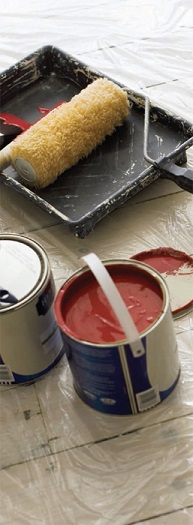DIY NATION
For a certain type of person, the sound of surrender is the ring of a phone as they call a repairman. That’s me. I will invariably attempt a home repair or improvement before I pay good money to someone else for a job I can do myself.
Does that make me arrogant? Maybe. Stubborn? Absolutely. Am I a cheapskate, too? I prefer the word “frugal.”
And I’m not alone.
From long-running television programs like This Old House to cable channels such as HGTV and the DIY Network, it should be obvious that do-it-yourself home improvement isn’t a passing trend so much as a lifestyle that’s been embraced for years by hard-working individuals from coast to coast. I mean, heck, the first settlers built their own homes long before building developers were throwing up high-rise condos, and we’re simply carrying the torch of that rich tradition of self-reliance.
For someone to follow this path requires an independent spirit, a willingness to break a little sweat and—maybe most important—an eagerness to learn new things.
I came aboard as editor of Extreme How-To in 2003 with a college degree and a raft of work experience from time spent laboring in a steel fabricating plant, an aluminum warehouse, a shipping hub, a framing shop—I could go on and on; I even once had a gig selling knives (and hated it). Although I was no home improvement expert at the time, I was young and ambitious and eager to learn. I was unafraid to try new things, and no matter what challenges I faced, I’d figure them out on the job.
I then spent many years studying all the things I realized I didn’t know about home improvement.
That’s where this book comes in. A collection of hundreds of tried-and-true techniques and pro tips for success, we cover the most common DIY projects inside and outside the home. For years the aim of Extreme How-To has been to demystify professional-grade projects for the do-it-yourselfer, to equip our readers with the know-how to “build it yourself, and build it better.”
If you’re willing to learn new things and you don’t worry about getting your hands dirty, this manual will help conquer your repairs and remodels without ever having to say “I surrender.”
READ THIS FIRST
If you’re new to home improvement, get ready for a wild ride. It’s a fun and satisfying journey, but as your projects grow more ambitious than simple fixes and minor improvements, you’ll find the big jobs can require a lot of work—much more than you’ll see edited into split-second TV clips on your favorite home show. Any job can be rife with unforeseen pitfalls, but trial-and-error can be a powerful teacher.
The best way to minimize errors is to gather as much information as you can prior to beginning your project. The Internet is a goldmine of home-improvement information, from Extreme How-To’s website to many others. You’ll find all sorts of helpful videos on Youtube—it’s amazing how detailed some of instructional clips are. For large projects like deck-building or shed construction, buy a book dedicated to the subject that details the various design options and techniques for construction. Another great way to soak up knowledge is to observe a jobsite. For example, if you spend a few minutes watching a roofing crew tear off and replace a home’s shingles, you might quickly decide that since you can’t be in that many places at once, maybe roofing is a project best left to the professionals.
GET A PERMIT
Some projects will require a permit from your local building department. In general, building codes are developed by industry associations “to provide minimum safety standards for a home’s occupants, the environment and the public at large.” The codes are adopted and enforced by local governments and vary based on local political issues, environmental regulations, and so forth. Check with your local building inspector to determine all local requirements.
Although codes vary from state to state, a permit is generally required for remodeling projects that involve changes to the building’s existing footprint, electrical system or plumbing. Adding new windows to existing walls usually requires a permit. You’re likely to need a permit for projects that go beyond a simple repair or cosmetic improvement, such as:
• adding supporting walls or removing load-bearing walls,
• in-ground concrete pool or a porch/deck,
• replacing the roof,
• backyard shed,
• concrete sidewalks, driveways and slabs
When a permit is filed, city officials will usually inspect the work completed at different stages to ensure it complies with current safety and health building codes.
When work is done to refresh the home, however, a permit is not usually required. Updating kitchen cabinets and countertops, for example, does not require a permit. Other remodeling updates such as flooring/ceiling coverings, painting/papering, tiling or carpeting can usually be done without a permit. Even if a permit isn’t required, certain projects may require licensed professionals for structural, electrical and plumbing work. If you’re not sure, check with your local city or county government office.

